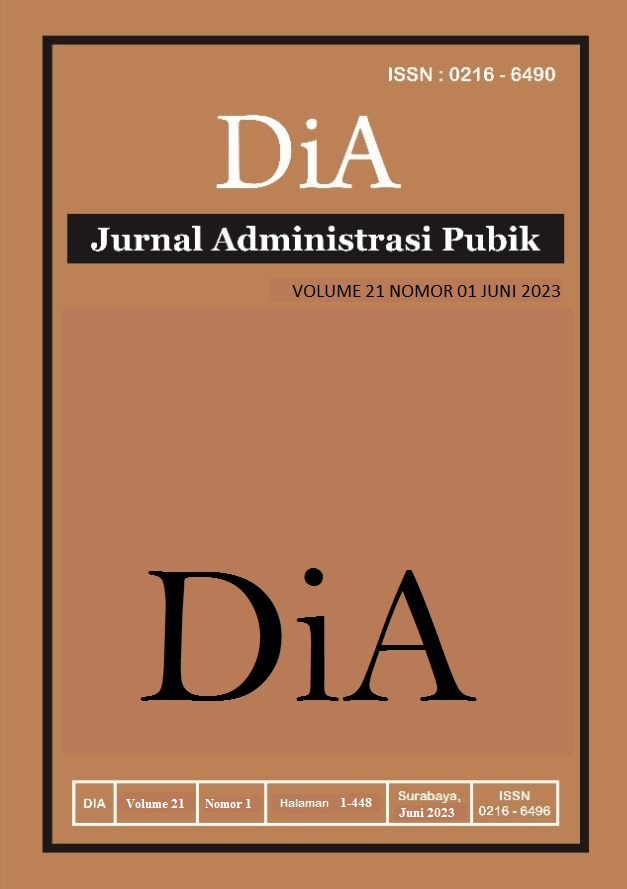AN ANALYSIS OF THE IMPLEMENTATION OF GENDER MAINSTREAMING IN THE PLACEMENT OF FEMALE POLICE OFFICERS AS COMPETENCY-BASED SECTOR POLICE CHIEFS IN THE METRO JAYA POLICE
Abstract
This study aims to analyse the gender mainstreaming of the Polri (Police of Indonesia Republic) at The Polda Metro Jaya (Province of DKI Jakarta Police) through the placement of policewomen as leaders in the Kapolsek (Region Sector Police) with the Indonesian social culture which still believes that a woman's duty is to take care of the household so that it does not give women the freedom to have a career, as well as the profession of policewomen by the public is seen as only part of the image of the police, where the presence of policewomen as a complement in the implementation of police duties and only placed in the functions of staff, personal secretary and administration. This research uses descriptive qualitative method by conducting interviews and field observations. Based on the research, there has been a policy in the framework of gender mainstreaming by placing female police officers as leaders in the police sector (Kapolsek) and there is no difference in the placement between female police officers and male police officers as police chiefs, but the successful implementation of gender mainstreaming has not been maximally implemented due to the lack of motivation of female police officers due to the challenges of police duties at The Metro Jaya Police which are quite complex and heavy police work dominantly related to crime cases and influenced by population density and territory as well as religious/community leaders in the police sector (Polsek) so that it requires the police chief to be ready to carry out 24-hour tasks to maintain security and order in the community.
Downloads
References
Abraham H. Maslow, Nurul Iman. (1993). Motivation and Personality Motivation Theory with a Human Needs Hierarchy Approach. Binaman Pressindo Library. Jakarta
Amelza D, Rycko & Surya Dharma. (2016), Police Organisational Behaviour.Yogyakarta: Student Library
Betti Alisjahbana. (2017). Perempuan Pemimpin Inspirasi 10 CEOs Building Families, Businesses and Communities. Mizan Library. Bandung
Data of Police Chief Position of Policewomen The Polda Metro Jaya from 2019 to 2022
Dorothy W. Cantor and Tonny Bernay (1998). Women In Power: Women in Politics. Jakarta: PT Gramedia
Dr Sitti Mujahida. S.Pd., S.E., M.M. (2018). Introduction to Management. Sah Media. Makasar
Gofur Ahmad. (2015). Assessment Centre Architecture. Grasindo. Jakarta
Handoko, Hani T. (2012). Personnel & Human Resource Management. Yogyakarta. BPFE Yogyakarta
Annual Report of the Operations Bureau of The Metro Jaya Police in. 2021
Assessment centre report of The Metro Jaya Police from 2019 to 2021
Report on the number of Polri employees at The Metro Jaya Police in April 2022
Lijan Poltak Sinambela. (2016). Human Resource Management Building a Solid Work Team to Improve Performance.PT Bumi Aksara, Jakarta
Luthan, Fred. (2011). Organizational Behaviour 12th Ed. New York: Mcgraw Hill
Northouse G., Peter. (2017). Leadership Theory and Practice; Translator: Ati Cahyani. Jakarta:Index
Rahadjo. (2007). Building Civilian Police: Legal, Social, And Societal Perspectives
Silvestri, Marisa. (2007). "Doing" Police Leadership: Enter the "New Smart Macho". Policing & Society, Vol. 17, No. 1, pp. 38-58
Syaiful F. Prihadi. (2004). Assessment Centre Identification, Measurement and Competency Development.SUN Printing. Jakarta
Wirawan. (2017). Leadership: Theory, Psychology, Organisational Behaviour, Application and Research. Jakarta: Rajawali Press.
Law of the Republic of Indonesia Year 1945
Law of the Republic of Indonesia No. 2 of 2002 on the National Police of the Republic of Indonesia
Law No. 27 of 2009 on the People's Consultative Assembly, the House of Representatives, the House of Regional Representatives, and the Regional House of Representatives
Presidential Instruction (Inpres) Number 9 of 2000 on gender mainstreaming in national development
Regulation of the Chief of the Indonesian National Police Number 5 of 2016 on the Implementation of Assessment Centre
National Police Chief Regulation Number 9 of 2016 on the career development system for members of the Indonesian National Police.
National Police Regulation No. 14/2018 on the Organisational Structure and Work Procedures of the Regional Police Force
Chief of the Indonesian National Police Regulation Number 3 of 2019 on Talent Management of the Indonesian National Police
Regulation of the Chief of the Republic of Indonesia National Police Number 4 of 2019 concerning selection of development education for public servants in the Republic of Indonesia National Police
Regulation of the National Police of the Republic of Indonesia Number 2 of 2021 concerning the Organisational Structure and Work Procedures at the Level of Resort Police and Sector Police.
https://www.un.org/en/conferences/women/mexico-city1975. accessed 2 February 2022
https://hdr.undp.org/en/countries/profiles/IDN. accessed 11 April 2022
https://humas.polri.go.id/informasi/uu-peraturan/ accessed 20 January 2022
National Commission on Violence Against Women 2020 annual record report can be seen at the link https://komnasperempuan.go.id/ uploadedFiles /1466.1614933645.pdf. accessed 16 March 2022
https://www.kemenpppa.go.id/index.php/page/read/26/3813/profil-perempuan-indonesia-tahun-2021. accessed 17 March 2022
Copyright (c) 2023 Yuliani Sariwaty Siregar, Nurliah Nurdin, Firman Hadi Rivai (Author)

This work is licensed under a Creative Commons Attribution-ShareAlike 4.0 International License.
The DiA journal allows authors to retain the copyright of their papers without limitation. Authors may grant publishers non-exclusive publishing rights to publish articles. Granting first publishing rights to publishers also qualifies as unlimited copyright (because there are no restrictions imposed by publishers on author copyright).










